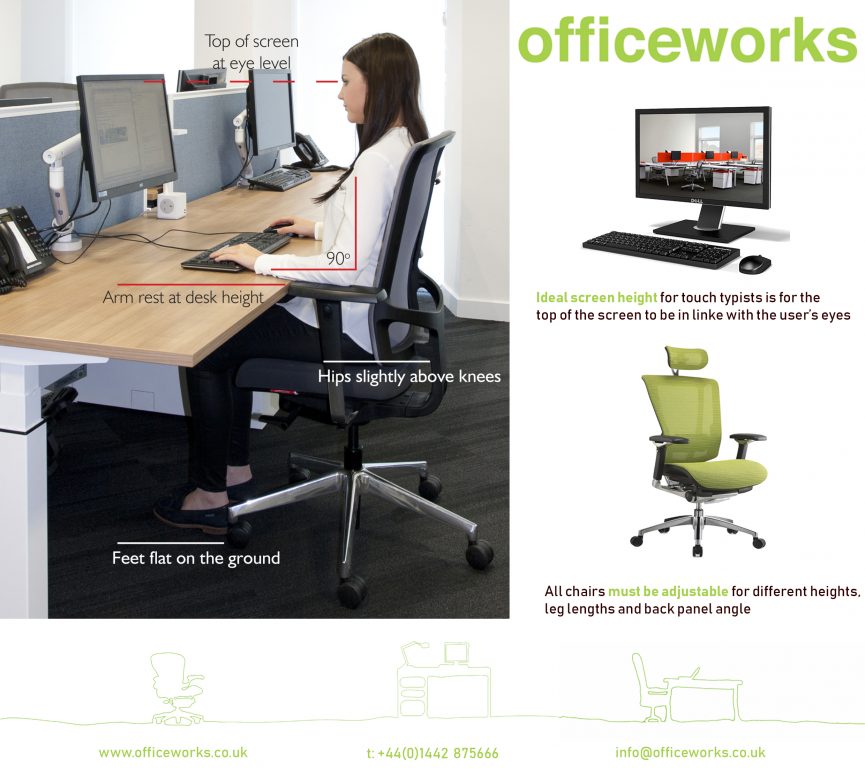By now many of us have been working from home for a couple of weeks and are settled into a spot where we like to work whether it’s a home office or the kitchen table. But without the ergonomic chair and desk we usually have in the office it’s easy to spend hours hunched over a laptop screen. Or constantly rearranging ourselves in our chair because it is so uncomfortable. We have some tips below to help look after your posture and make your home set up as pain free as possible.
Support your back
If you are able to use an office chair reduce your risk of back pain by adjusting your chair so your lower back is properly supported by changing the height, back position and tilt.
If you are using any other sort of chair then using cushions can help to support your lumbar and pad the bottom of the chair.
Adjust your chair
Adjust your chair height so that with shoulders relaxed you can use the keyboard with your wrists and forearms straight and level with the floor. This can help prevent repetitive strain injuries.
Your elbows should be by the side of your body so your arm forms an L-shape at the elbow joint.
If you are sitting at a kitchen table be aware that the average table is around 3cm higher than your desk, and your kitchen chair 3cm lower.
Rest your feet on the floor
Ideally you need to place your feet flat on the floor. If they’re not, and you have one, use a footrest, which lets you rest your feet at a level that’s comfortable or use a chunky book to rest your feet on to take the pressure off your thighs and hips.
Whist it’s tempting don’t cross your legs, as this may contribute to posture related problems.
Place your screen at eye level
Your screen should be directly in front of you. A good guide is to place the monitor about an arm’s length away, with the top of the screen roughly at eye level.
If the screen is too high or too low, you’ll have to bend your neck, which can be uncomfortable.
If you don’t have one try making your own laptop stand by angling a lever-arch file or a chopping board on top of a book to use as a ramp for your laptop. If you don’t have a table at all, make sure that you change the place that you work. Experts recommend standing up and working at a kitchen counter, or even using an ironing board at standing level (propped against the wall) to mix things up. Sitting on the floor and putting your laptop on a sofa or coffee table is also an option.
Have the keyboard straight in front of you
The worst posture issues will come from hunching over a laptop. Getting a keyboard and a mouse is the most important investment that people can do to immediately improve their work environment.
Place your keyboard in front of you when typing and ideally leave a gap of about 4 to 6 inches (100mm-150mm) at the front of the desk to rest your wrists between typing.
Keep your arms bent in an L-shape and your elbows by your sides. A wrist rest to keep your wrists straight and at the same level as the keys is also a good idea.
Keep your mouse close
Again it is important to position and use the mouse as close to you as possible. A mouse mat with a wrist pad may help keep your wrist straight and avoid awkward bending.
If you’re not using your keyboard, push it to one side to move the mouse closer to you.
Avoid screen reflection
Your screen should be as glare-free as possible. If there’s glare on your screen, hold a mirror in front of the screen so you know what’s causing it.
Position the monitor to avoid reflection from overhead lighting and sunlight. If necessary, pull blinds across the windows.
Adjusting the screen’s brightness or contrast can make it much easier to use.
Avoid phone strain
Repeatedly cradling the phone between your ear and shoulder can strain the muscles in your neck so if you spend a lot of time on the phone, try exchanging your handset for a headset or earphones.
Walking round the house when you’re on a call is a great way to keep moving, keep energy levels up and give your eyes a from looking at a screen.
Take regular breaks
It’s important to move around every half an hour to avoid sitting in the same position for too long and making sure you change your posture as often as is practicable.
Frequent short breaks are better for your back than fewer long ones. It gives the muscles a chance to relax while others take the strain.
Some simple exercises include stretching your arms towards the sky and to the sides. Every hour, try laying with flat on the ground and your legs at a 90 degree angle to stretch the muscles in your back. Walk around while you’re on the phone if you can, and run up and down stairs if you have them.
